09. Strawberries and Cream
Caramelised honey cream, fig leaf oil macerated strawbs and spelt crumble
Hiya!
I hope you’ve had a great week.
Welcome back to the Roll with it newsletter. In this edition we’re gonna be looking at elevating a cult classic dessert of strawberries and cream - it is Wimbledon after all!
Ok, let’s use that sugar knowledge to get us going. Oh, and don’t forget to put my Dad’s playlist on!
Cissy … xo
I know, I know, you shouldn’t play around with the classics BUT I think going a little extra on this is a great way to show off some of your pastry skills without putting in days and days of work. It’s a perfect recipe for those warm summer evenings too.
Since we’ve been talking about sugar - where it comes from, how it's processed, etc. I thought it would be interesting to see how different sugars change flavour after caramelisation. To do this, I tested 4 different types of sugar, making a dry caramel of each before incorporating into cream.
When you caramelise sugar, the flavour profile of the ingredient completely changes (in some cases for the better). Scientifically what happens is the water in the sugar is evaporated off until it becomes super concentrated and its boiling point rises. When this happens a chemical reaction occurs, resulting in brown/amber sugar molecules that are sticky and have a nutty and toasty aroma.
Throughout the caramelisation process there are several stages, identified by different temperatures. These are:
Thread stage (110c) - sugar forms thin threads that can make syrups
Soft ball stage (115c) - sugar forms into a soft ball that can be moulded into candies or fudge
Firm ball stage (118-120c) - the sugar is slightly more firm and can be made into meringues and marshmallows
Hard ball stage (121-130) - the sugar holds its own shape and can be made into nougat or butterscotch
Soft crack stage (132-143c) - the sugar is pliable and can be shaped into chewy candies like taffy
Hard crack stage (146-154c) - the sugar has hardened and can make hard caramel candies
Caramel stage (170c) the caramelisation is complete
You can use a sugar thermometer to take accurate readings, however for this recipe I don’t bother. When the sugar turns dark and smells nutty you know it’s reached the caramel stage. If it starts to smell like burnt toast then it’s gone too far.
Surprisingly the colour of these caramel creams are not what you might assume! The palest cream is actually made using soft brown sugar, the darkest is the panela and the medium coloured is the caster sugar. The reason the caster sugar is darker than the soft brown sugar is because I didn’t caramelise the soft brown sugar for long enough. I freaked out and thought it was burning so took it off the heat but it was actually fine and I could have taken it darker, but at that stage there was no going back. Top tip - don’t freak out!
Soft brown sugar caramel cream: soft brown sugar is made by blending refined white sugar with molasses. It is naturally moist and has a wet sand like texture, due to the way the molasses coats each sugar crystal. Because I didn’t caramelise this as long as I would like, the flavour was quite neutral. There was an obvious treacle-like taste but it wasn’t very punchy.
Panela caramel cream: panela is a raw, unrefined cane sugar similar to jaggery. It is made by crushing cane sugar, boiling it into a liquid and then pouring it into moulds. Unlike caster sugar, panela contains molasses which gives it a strong, more intense flavour. Caramelising it for this recipe intensified its gingery, earthy, wintery, cinnamony and rich flavour profile.
You can buy panela in most health food shops here in Dublin. It's often labelled as Rapadura sugar. It’s more commonly available throughout the UK and America.
Caster sugar caramel cream: caster sugar is refined white sugar with very little taste apart from being sweet. When caramelising it, you unlock a whole new level of flavour. The sugar becomes more rich and nutty.
Once my creams had set, I plated them up and tasted them with strawberries. The panela was far too rich for the fragrant fruit and whilst both the caster and brown sugar were complimentary, they weren’t quite what I was looking for.
So I stepped out of the kitchen for a while, until in the middle of the night I thought ‘what about using honey?!’ The next day I tested this and oh baby was it good! Now, I’m not talking about your bog standard honey from the supermarket (is it even honey? An investigation for another time…) I’m talking about good, local raw stuff.
A couple of years ago I was lucky enough to go down to my mate Jake’s house in Wicklow, where he and his family kept bees. Before I left, Jake gave me a whole hive frame to take home, which was very generous of him! Not really knowing what to do with it, I just scraped the honey out of the frame into a jar, wax and all. Even now, I’m still trying to get through it. This particular honey is dark and strong in flavour, tasting like hedgerow berries and blossoms.
Honey, unlike sugar, is a sweet liquid produced by bees. The bees feed on the nectar of flowers. The nectar reacts to their saliva causing a chemical reaction, which creates honey. Honey has been used for centuries, both in cooking and for its medicinal properties. It is a lot sweeter than sugar and caramelises a lot quicker. Most dark coloured honeys have a more intense flavour compared with lighter ones. For this recipe, please search out a good raw, local one.
Strawberries and Cream Recipe
(Serves x 4)
Caramelised Honey Cream
350ml double cream
1.5g gelatine (I used Dr Oetker’s platinum gelatine leaves)
50g honey
1g fine sea salt
½ vanilla pod (optional)
Method
Scrape the seeds out of ½ a vanilla pod and put into a small saucepan with the cream.
Warm gently.
Whilst the cream is heating, bloom the gelatine in ice cold water.
Once the cream is steaming, take it off the heat
Remove the gelatine from the water, squeezing off any excess water. Put in a bowl and set aside.
In a separate saucepan (preferably stainless steel, so you can see the honey change colour) melt the honey on a medium-low heat. Swirl the pan a couple of times, noticing the bubbles change from large to small. The honey has caramelised when it is visibly darker in colour. Be careful as this will happen very quickly.
Once caramelised turn off the heat and slowly pour in the hot cream, whisking as you go. (If you add cold cream to hot caramel, the sugar can crystallise because of the heat shock).
Pour the hot honey cream over the bloomed gelatine and salt. Stir until combined.
Taste and adjust the salt.
Using a handheld blender blitz until homogeneous.
Pour into a container and chill for at least 6 hrs. Or, freeze for around 30 mins before transferring to the fridge for another 2hrs.
Once the mix is set, whisk to a medium peak with a stand mixer. If you happen to over whip it - don’t worry! Pour in a couple of tablespoons of double cream to loosen it out.
Serve immediately or chill again until ready to serve.
Keeps for up to 3 days un-whipped or whipped.
Macerated Strawberries with Fig Leaf Oil
Fig Leaf Oil (optional)
This recipe is adapted from Anna Higham’s The Last Bite.
A handful of fig leaves
250ml neutral oil (such as grapeseed or vegetable)
Method
Remove the stalks from the fig leaves.
Blanch the leaves in boiling water for 2 mins. Drain and immediately put in a bath of ice water. (This stops them cooking).
Once cool, squeeze out as much excess water as possible.
Roughly chop the leaves and put in a blender, along with the oil.
Blend at high speed until the oil gets hot and the colour changes from a grassy colour to a forest green oil.
Strain the liquid through a sieve lined with muslin. Don’t stir it! Just let it hang out and do its thing.
Macerated Strawberries
450-500g strawberries
15-20g golden caster sugar
A squeeze of lemon juice
Method
Hull strawberries and cut into quarters.
Place in a bowl with the sugar and lemon juice.
Toss gently to coat and leave to macerate for an hour.
When ready to serve, drizzle with fig leaf oil.
Spelt Crumble (optional)
I like to add some sort of crunchy element to a dessert that is smooth and sweet. This crumble can be made ahead and stored in an airtight container for up to 1 month (which is dangerous because then I just snack on it!) Or, you can freeze the raw dough for up to 3 months and bake from frozen whenever you need.
Alternatively, you could also use toasted, chopped nuts.
55g unsalted butter, cold, cubed
25g soft brown sugar
25g demerara sugar
25g rolled oats
1g flaky sea salt
120g spelt flour
Method
Place all ingredients in the bowl of a stand mixer and paddle until large crumbs form.
If the mix doesn’t look like it’s coming together add a tiny splash of water. This will help bind everything.
Lay the crumble out on a baking sheet lined with paper. Chill for 30 mins.
Preheat the oven to 180c.
Bake for 15 (ish) mins, until golden.
Now divide the whipped caramelised honey cream between 4 plates (around 50g each), top with a sprinkling of the spelt crumble and then the macerated strawberries. Drizzle over a little extra fig leaf oil for good measure.

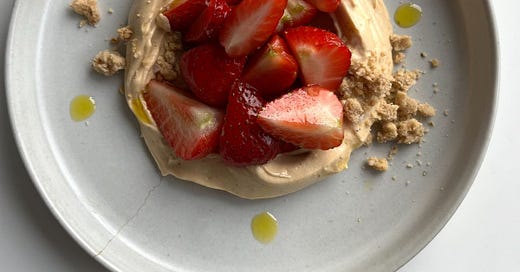



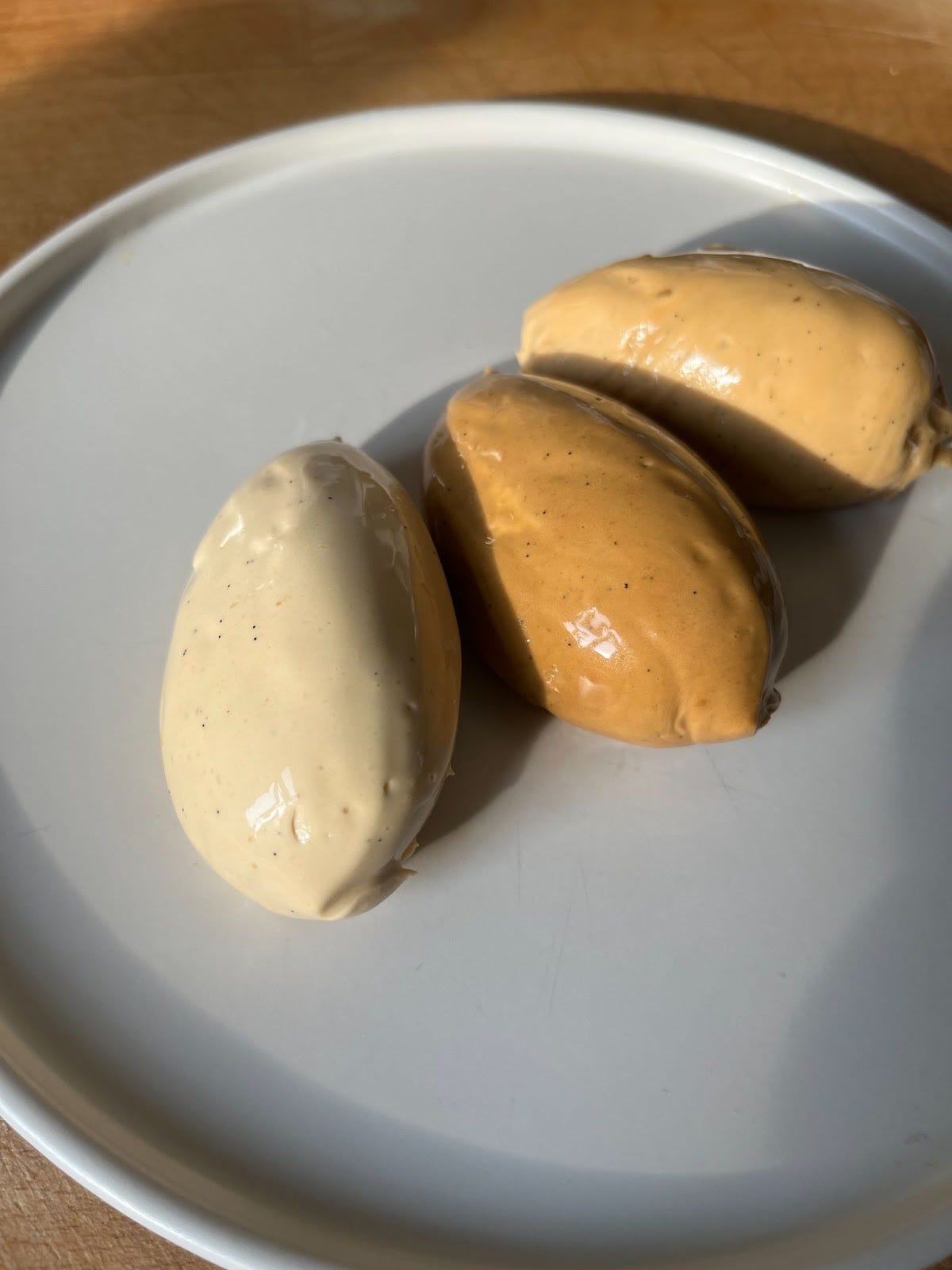
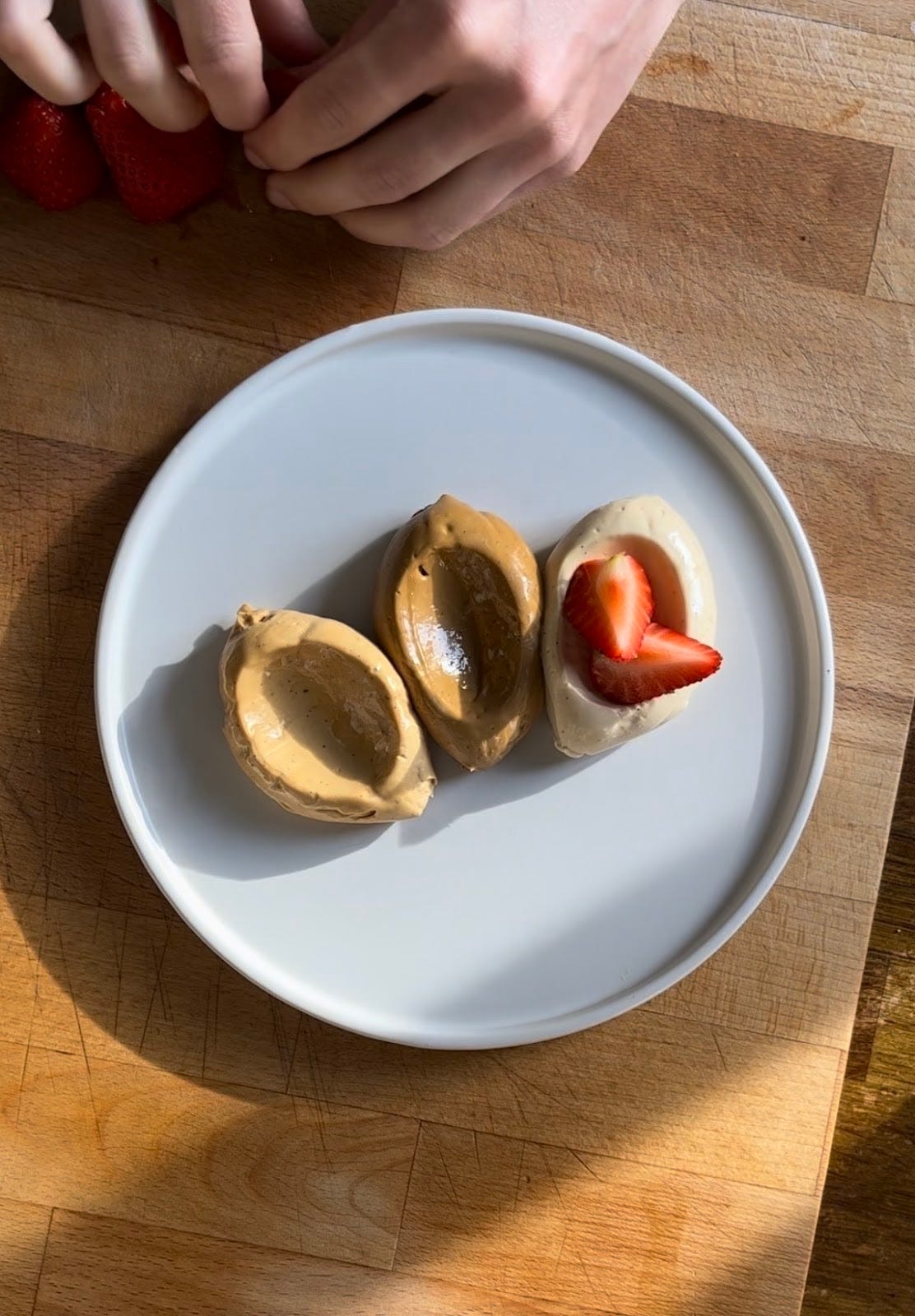
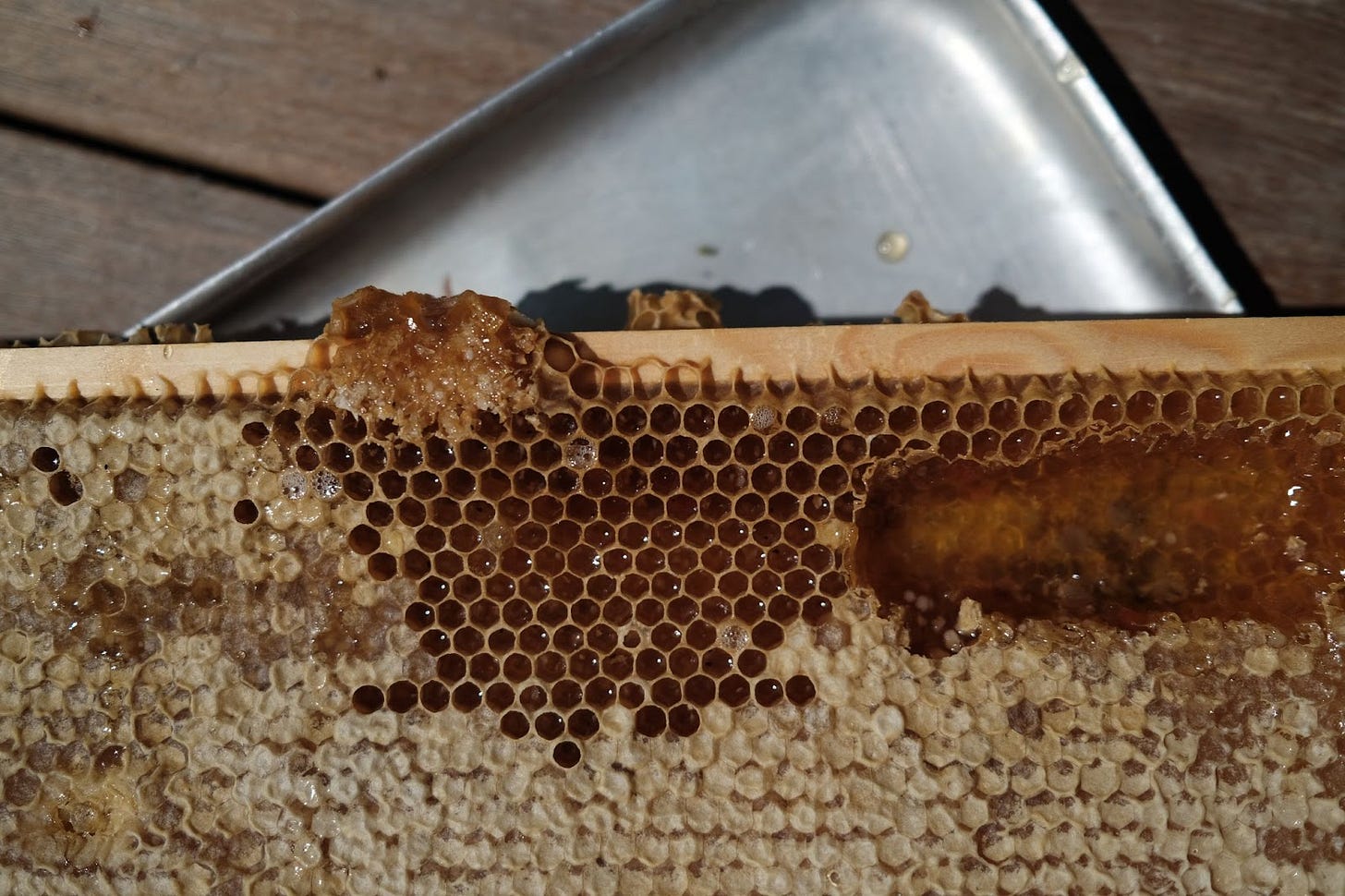

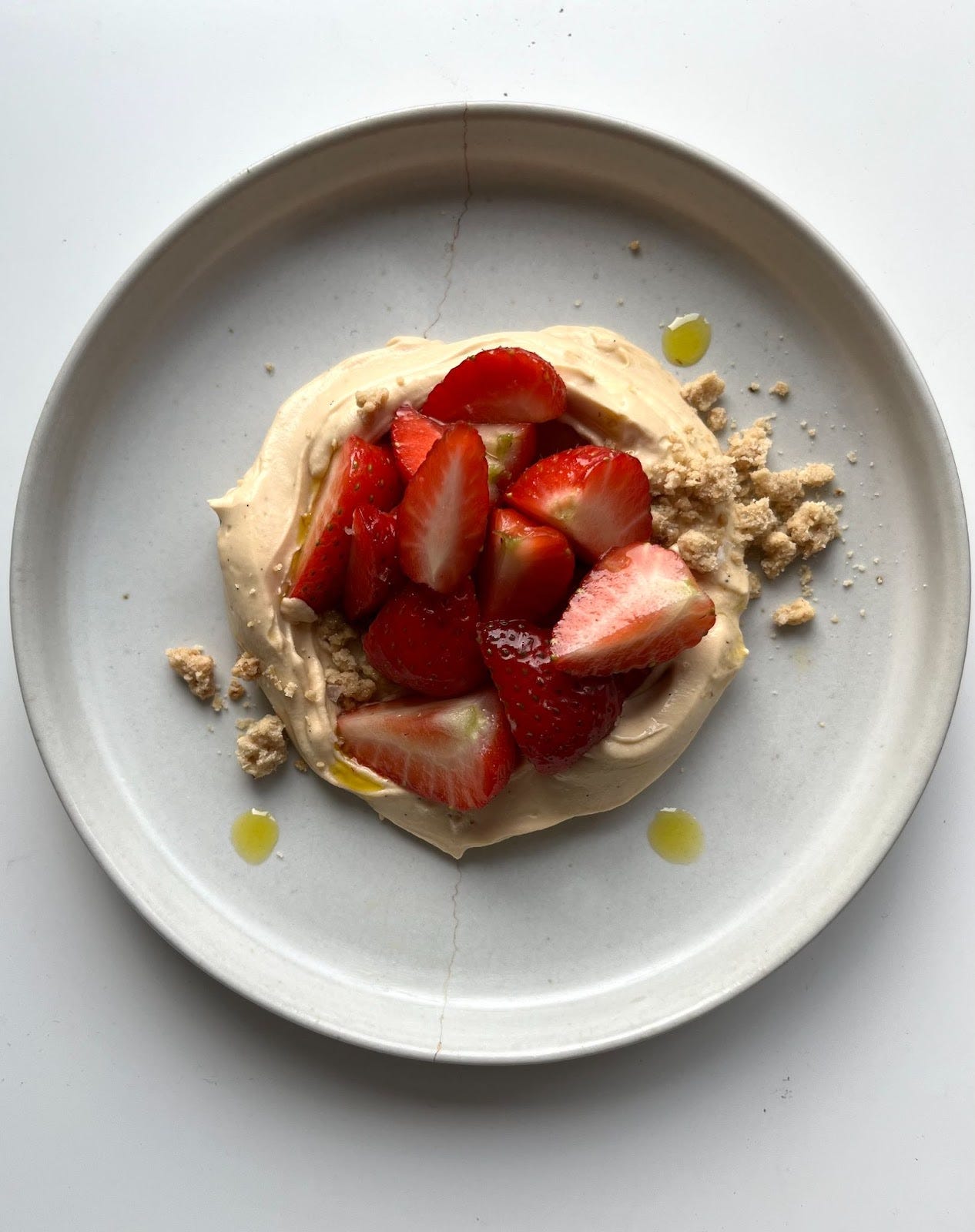


Hey, very cute
I love your creativity and the way it inspires me. Thanks for sharing♡